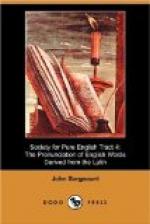Even so early as the beginning of the fifth century, St. Augustine tells us that the vowel-quantities, which it was necessary to learn in order to write verse correctly, were not observed in speech. The Latin-speaking schoolboy had to learn them in much the same fashion as did the English schoolboy of the nineteenth century.
It is interesting to observe that, while the English scholars of the tenth century pronounced their Latin in the manner which their ancestors had learned from the continental missionaries, the tradition of the ancient vowel-quantities still survived (to some extent at least) among their British neighbours, whose knowledge of Latin was an inheritance from the days of Roman rule. On this point the following passage from the preface to [AE]lfric’s Latin Grammar (written for English schoolboys about A.D. 1000) is instructive:—
Miror ualde quare multi corripiunt sillabas in prosa quae in metro breues sunt, cum prosa absoluta sit a lege metri; sicut pronuntiant pater brittonice et malus et similia, quae in metro habentur breues. Mihi tamen uidetur melius inuocare Deum Patrem honorifice producta sillaba quam brittonice corripere, quia nec Deus arti grammaticae subiciendus est.
The British contagion of which [AE]lfric here complains had no permanent effect. For after the Norman Conquest English boys learned their Latin from teachers whose ordinary language was French. For a time, they were not usually taught to write or read English, but only French and Latin; so that the Englishmen who attempted to write their native language did so in a phonetic orthography on a French basis. The higher classes in England, all through the thirteenth century, had two native languages, English and French.
In the grammar schools, the Latin lessons were given in French; it was not till the middle of the fourteenth century that a bold educational reformer, John Cornwall, could venture to make English the vehicle of instruction. In reading Latin, the rhythmically-determined vowel-quantities of post-classical times were used; and the Roman letters were pronounced, first as they were in French, and afterwards as in English, but in the fourteenth century this made little difference.




